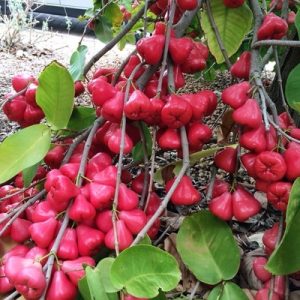Syzygium samarangense
Wax apple, wax jambu, Java apple
Origin
Syzygium and Eugenia are closely related genera, hailing originally from old and new world tropical regions respectively. Both are now grown round the world in suitable pantropical areas. This species is the most important commercially grown Syzygium in south east Asia, and is widely marketed there. It is polyploid with 2n=22 to 110, and genetically is very closely related to Syzygium aqueum (Bell apple).
Climate
It prefers moist warm climates (above 18°C and not below 7°C) up to 1000m, and can withstand some dry conditions provided there is adequate water supply. Abnormal high and low temperatures inhibit fruit colour development.
Plant Description
It is a small evergreen tree, 3-10m, with a short trunk and broad crown. Branchlets are terete or quadrangular. The opposite coriaceous ovate glabrous leaves (10-15 X 5-10cm) with an entire margin and short thick petioles (3-4mm) are pink to violet when young and green when mature, and have a symmetric cordate or rounded base with an obtuse to acuminate apex. Assisting identification, there are 7-14 pairs of secondary veins with an intra-marginal arched vein about 6mm from the lamina mid-point margin. Leaves are aromatic when crushed.
Relatives
It belongs in the large Myrtaceae family. Syzygium consists of over 1200 species and has long been understudied by taxonomists because of the relative absence of clearly distinguishing features. As a result there has been considerable confusion, historically and currently, with their naming in the scientific community and more so by Nurseries and the public. Some other fruit trees of interest in the family include guava, jaboticaba, feijoa and grumichama.
Soils
Heavy fertile soils are preferred.
Propagation
Seeds are recalcitrant but germinate readily. Marcotting, cuttings and budding are also used.
Cultivars
Selection and breeding in south east Asia has produced some superior varieties which are larger and more crisp, mildly sweeter and have better handling and storage properties. These include Pink, Deep Red, Pearl and Black Pearl, but are difficult to source here, with most Nursery plants being of unknown parentage.
Flowering and Pollination
Wax apple appears to need a brief dry period to flower. Inflorescences are drooping cymose panicles, usually terminal but also in abscised leaf axils. They have 3-25 fragrant self-fertile flowers, 3-4cm in diameter, with a 1.5cm lobed calyx tube and four separate (ie unfused) lobed yellow-white petals (1-1.5cm long). Flowers have an inferior ovary, with >50 creamy-white stamens and a single central style, both about 2.5cm long. Three systems of breeding exist – apomictic, self-pollination and cross-pollination, and a variety of insects can serve as pollinators.
Cultivation
Trees need only minimal attention during the juvenility period, apart from early shaping and adequate watering. They will grow in sandy soils but produce better fruit in loams with good organic matter content. Fertilisation is beneficial after the inflorescences have formed; before this, new growth will compete with flowers for nutrients. Paper bagging of fruit clusters and leaf/fruit ratio enhance fruit colour, and yield is related to canopy photosynthate production. A number of different labour-intensive cultural and chemical management strategies have been developed in Taiwan involving pruning, thinning, root pruning, girdling, shading and fertilisation coupled with plant hormone sprays to control vigour and induce flowering in desired time windows, often also increasing yield and skin colour.
Wind Tolerance
The large leaves mean the tree can be damaged by strong winds and fruit may also be bruised.
Pruning
There is little general information on this, but standard practices of selecting major scaffolding branches when young, maintaining size, removing dead branches, and keeping the canopy relatively open for optimal fruit ripening/colouring and to minimise diseases, can all assist.
The Fruit
The conical-pyriform waxy and glossy fruit (5-7 X 4-5cm, 60-100g, exceptionally more than 200g) is a berry with a fleshy calyx at the apex which has incurved lobes. The smooth skin is very thin and can be white, greenish-white, pink, red, maroon or dark purple. The white flesh is watery, spongy, crisp, low acid (mainly citric acid) and aromatic, but commonly only mildly sweet; pink skinned fruit are usually juicier. There can be 0-3 globose seeds up to 1cm in diameter, and fruit usually ripen within 40-70 days from anthesis. Wax apple has little nutritional value apart from being a low calorie food with over 90% moisture content and slight polyphenol antioxidant activity, mainly as anthocyanins.
Fruit Production and Harvesting
Seedlings may take 3-5 years to come into fruiting, with marcots in roughly half this time. Fruit growth exhibits a simple sigmoidal pattern. A mature tree can produce many hundreds of fruit in clusters (with yields over 50kg/tree possible) and in its native areas it can fruit throughout much of the year. Lower fruit on the tree have the largest fruit while those in the upper canopy are smaller but more strongly coloured. Because of the thin skin, fruit have to be handled very carefully. If irrigation is not regular, the fruit skin can crack. Ripe fruit should be picked every few days. It’s non-climacteric so won’t ripen further after harvesting, and as a highly perishable fruit will last for a only few days at room temperature; chilling injury becomes apparent if stored below 10°C.
Fruit Uses
Usually eaten fresh out of hand as a thirst quencher, and the rather bland flavour can be enhanced with sugar, spices, sauces etc. The edible portion is 90-95% of the fruit, which can be processed by pickling, light stewing, sautéing or made into jams and jellies. In developing countries it has often been used in traditional folk medicine for treating all manner of ailments.
Pests and Diseases
Generally a low maintenance species. Problems that have been reported worldwide are shoot dieback, bacterial wilt, sooty mould, oriental fruit fly, thrips and scale.
Comments
This is an easily grown species in Perth and surrounds, producing copious quantities of pretty fruit. Efforts to obtain a superior variety are worthwhile. The small evergreen tree also makes a fine ornamental addition to the garden.
